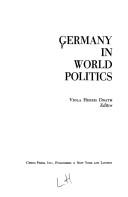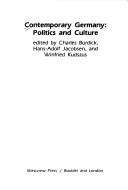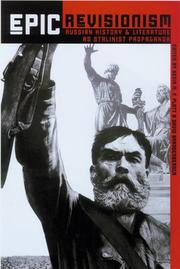| Listing 1 - 6 of 6 |
Sort by
|
Multi
ISBN: 9781474416566 9781474416573 9781474437523 9781474416580 1474416578 147441656X Year: 2018 Publisher: Edinburgh Edinburgh University Press
Abstract | Keywords | Export | Availability | Bookmark
 Loading...
Loading...Choose an application
- Reference Manager
- EndNote
- RefWorks (Direct export to RefWorks)
The battles fought in the name of the 'war on terror' have re-ignited questions about the changing nature of war, and the experience of war for those geographically distant from its real world consequences. What is missing from our highly mediated experience of war? What are the intentional and unintentional processes of erasure through which the distortion happens? What are their consequences?
Cinema is a key site at which questions about our highly mediated experience of war can be addressed or, more significantly, elided. Looking at a range of films that have provoked debate, from award-winning features like 'Zero Dark Thirty and American Sniper', to documentaries like 'Kill List and Dirty Wars', as well as at the work of visual artists like Harun Farocki and Omer Fast, this book examines the practices of erasure in the cinematic representation of recent military interventions. Drawing on representations of war-related death, dying and bodily damage, this provocative collection addresses 'what's missing' in existing scholarly responses to modern warfare; in film studies, as well as in politics and international relations.
WAR FILMS--HISTORY AND CRITICISM --- Film --- War films --- Motion pictures and war. --- History and criticism. --- War films History and criticism --- History and criticism
Book
ISBN: 9780812248777 Year: 2017 Publisher: Philadelphia : University of Pennsylvania Press,
Abstract | Keywords | Export | Availability | Bookmark
 Loading...
Loading...Choose an application
- Reference Manager
- EndNote
- RefWorks (Direct export to RefWorks)
As Islamist terrorism has ravaged the contemporary Middle East and led to sporadic attacks in Europe and the United States, countless journalists, pundits, and politicians have turned their attention to the question of what motivates those who commit violence in the name of political beliefs. Terrorism is not solely the preserve of Islam, however, nor is it a new phenomenon. It emerges from social processes and conditions common to societies throughout modern history, and the story of its origins spans centuries, encompassing numerous radical and revolutionary movements. Marc Sageman is a forensic psychiatrist and government counterterrorism consultant whose bestselling books Understanding Terror Networks and Leaderless Jihad provide a detailed, damning corrective to commonplace yet simplistic notions of Islamist terrorism. In his comprehensive new book Turning to Political Violence, he examines the history and theory of political violence. Sageman excavates primary sources surrounding key instances of modern political violence, looking for patterns across a range of case studies spanning the French Revolution, through late nineteenth- and early twentieth-century revolutionaries and anarchists in Russia and the United States, to the assassination of Archduke Ferdinand and the start of World War I. In contrast to one-dimensional portraits of terrorist "monsters" offered by governments and media throughout history, these accounts offer complex and intricate portraits of individuals engaged in struggles with identity, injustice, and revenge who may be empowered by a sense of love and self-sacrifice. Arguing against easy assumptions that attribute terrorism to extremist ideology, and counter to mainstream academic explanations such as rational actor theory, Sageman develops a theoretical model based on the concept of social identity. His analysis keys on the complex dynamic between the state and disaffected citizens that leads some to disillusionment and moral outrage, and a few to mass murder. Sageman's account offers a paradigm-shifting perspective on terrorism that yields stark new implications for the ways liberal democracies can and should confront political violence
German literature --- Music --- Romanticism --- History and criticism --- Political violence --- Radicalization --- Terrorism --- Terrorists --- Violence politique --- Terrorisme --- History. --- Psychology --- Histoire. --- Histoire

ISBN: 0915326132 Year: 1979 Publisher: London Cyrco Press
Abstract | Keywords | Export | Availability | Bookmark
 Loading...
Loading...Choose an application
- Reference Manager
- EndNote
- RefWorks (Direct export to RefWorks)

ISBN: 0865314438 Year: 1984 Publisher: Boulder, CO : Westview,
Abstract | Keywords | Export | Availability | Bookmark
 Loading...
Loading...Choose an application
- Reference Manager
- EndNote
- RefWorks (Direct export to RefWorks)

ISBN: 1282270052 9786612270055 0299215032 9780299215033 9781282270053 6612270055 0299215008 0299215040 9780299215002 9780299215040 Year: 2006 Publisher: Madison, Wis. University of Wisconsin Press
Abstract | Keywords | Export | Availability | Bookmark
 Loading...
Loading...Choose an application
- Reference Manager
- EndNote
- RefWorks (Direct export to RefWorks)
Popular culture --- Russian literature --- History in literature --- Propaganda, Soviet --- Communism and literature --- Ideology and literature --- Russia & Former Soviet Republics --- Regions & Countries - Europe --- History & Archaeology --- Political aspects --- History and criticism --- History --- History in literature. --- Communism and literature. --- Ideology and literature. --- History and criticism. --- Political aspects. --- Literature and communism --- Literature and ideology --- Soviet propaganda --- Culture, Popular --- Mass culture --- Pop culture --- Popular arts --- Communication --- Intellectual life --- Mass society --- Recreation --- Culture --- Literature
Book
ISBN: 2718605359 9782718605357 Year: 2000 Publisher: Paris Galilée
Abstract | Keywords | Export | Availability | Bookmark
 Loading...
Loading...Choose an application
- Reference Manager
- EndNote
- RefWorks (Direct export to RefWorks)
Motion pictures --- Television broadcasting --- Advertising --- Mass media --- Social aspects --- -Motion pictures --- -Television broadcasting --- -#A0103A --- 690 Media, mediarecht --- 651 Maatschappij. Algemeen --- Telecasting --- Television --- Television industry --- Broadcasting --- Cinema --- Feature films --- Films --- Movies --- Moving-pictures --- Audio-visual materials --- Performing arts --- Ads --- Advertisements --- Advertising, Consumer --- Advertising, Retail --- Advertising, Store --- Commercial speech --- Consumer advertising --- Retail advertising --- Speech, Commercial --- Store advertising --- Business --- Communication in marketing --- Industrial publicity --- Retail trade --- Advertisers --- Branding (Marketing) --- Propaganda --- Public relations --- Publicity --- Sales promotion --- Selling --- History and criticism --- SellingSocial aspects --- #A0103A --- Society and advertising --- 360 --- cinéma --- communication --- télévision --- pers en communicatie --- presse et communication --- Motion pictures - Social aspects --- Television broadcasting - Social aspects --- Advertising - Social aspects --- Mass media - Social aspects
| Listing 1 - 6 of 6 |
Sort by
|

 Search
Search Feedback
Feedback About UniCat
About UniCat  Help
Help News
News